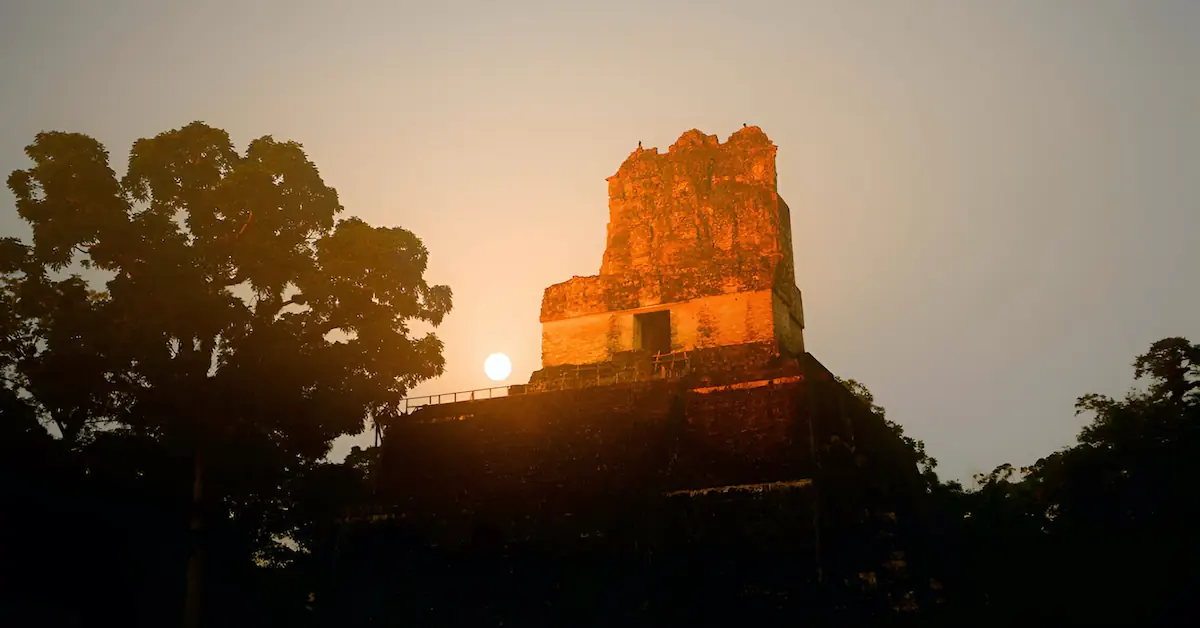Visit Mayan ruins in Guatemala and Belize
Explore the Ancient Mayan World
There’s something about the Maya people that has always fascinated the world. When you visit Mayan ruins, you can really see how advanced they were. Throughout this journey through the Mayan world, you’ll repeatedly see architectural, astrological, and engineering marvels that were built hundreds, if not thousands of years ago. While some Maya culture does still remain, the real highlights of the culture are found in these ancient structures. You’ll have a chance to walk where these people once walked. It’s far different to step into history than just to read about it.
On this journey through two countries, you’ll visit a minimum of six ancient cities. It quickly becomes evident how different each settlement was. Some of the cities got along and traded, working together, while others fought and warred with each other. As you look at the buildings, the different architecture, and the artifacts found in these ruins, you’ll start to understand just how varied the Mayan people were. It’s quite eye opening and worth the trip.
Tikal
Meet the might of the Maya
Yaxha
Where Mayan history flows
Xunantunich
Walk in the footsteps of kings
Caracol
Belize’s largest Mayan City
Highlights
On this tour, you’ll visit Mayan ruins in Belize and Guatemala. You’ll see the Maya people in a whole new light as you sit atop a temple in Tikal, watching the sun rise over the jungle. Explore the pretty, colonial island of Flores and take a boat tour of the lake to get a real feel for this tropical paradise. You’ll experience El Mirador (helicopter access only), Yaxha, and Flores in Guatemala before you move on to Belize.
Once across the border, you can explore the fascinating Xunantunich, Cahal Pech, Caracol, with its Sky Temple, and Altun-Ha. Each of these Mayan cities is unique, with its own style of architecture, history, and type of location, based on whether the population was military, built for trade, or another purpose. You’ll swim under waterfalls, hike through the jungle, spot tropical birds, and eat delicious local meals. It’s an experience to remember!
Itinerary
Your flight will arrive in Flores Mundo Maya airport where our guide will pick you up and take you to your jungle lodge inside Tikal National Park. You’ll have the evening to do some exploring and relaxing after a long travel day.
- Two nights in Tikal.
Hopefully, you slept well last night, because you’ll be up nice and early today for a sunrise tour of Tikal. You’ll get to see a side of these ruins that very few people get to see.
Follow your guide through the dark jungle to Temple IV. You’ll climb to the top, where you have a panoramic view of the treetops as the sun rises. The fog burns away as the birds wake and howler monkeys begin their day. Everywhere you look, you’ll see lush jungle canopy and Mayan temples jutting up from the trees. It’s a magical sight.
After returning to the lodge for breakfast, we’ll head out for a more exploratory tour of the Mayan city. Tikal was one of the largest pre-Columbian Mayan cities. At one point, it had nearly 100,000 inhabitants. It wasn’t until recently that researchers realized this UNESCO World Heritage Site was far larger than they realized. LIDAR was used to scan below the jungle canopy and showed the city actually spread further out than anyone realized. Most of the ruins are still hidden beneath centuries of growth and dirt, but some areas (roughly 5% of the entire city) have been excavated. You can explore these.
While we call the city Tikal, which means “at the waterhole” in Yucatec, the original name was Yax Mutul or “First Mutal.” Tikal also has the distinction of being Guatemala’s first national park, established in 1955. The park covers over 350 square miles and is a popular tourist destination these days.
Since Tikal was occupied for centuries and had at least 33 rulers, it has some very interesting artifacts. Like many Mayan ruins, you’ll find massive stone pyramids here, but the history here is fascinating. The Temple of the Great Jaguar and the Temple of the Masks were built so precisely that they are used to calculate the Mayan calendar, according to astrological alignments. The Mayans were intelligent and understood equinoxes and solstices, measuring everything with their temples and architecture. You’ll learn more about this as you walk through the Mundo Perdido (Lost World) complex with your guide.
It’s easy to imagine what life was like back when the city was full of people. Even with the jungle closing in, the beautiful birdsong filling the air, you can almost see women selling their wares, players playing in the ball courts, and children playing. It’s a chance to experience something every visitor to Guatemala should experience.
After a tasty local breakfast, it’s time to pack up and head to Yaxha. While not far from Tikal, this Mayan city tends to be quieter and less touristy since it’s a little off the beaten path. The name Yaxha means “green water” and refers to the two lakes nearby, Yaxha and Sacnab.
Outside of Tikal, it’s quite unusual to see twin pyramid complexes, but Yaxha features one. It was used to commemorate the K’atun cycles based on the Long Count calendar. Since the stars and astronomy were so important to the Maya people, they used their architecture to aid in keeping track of it. This is also interesting because it shows that Tikal and Yaxha had an exchange of culture and ideas at some point in history.
When you visit Yaxha, you should expect to spend quite a bit of time examining the stelae there. These are stone monoliths covered in carvings and hieroglyphs. Around 40 of the story-telling stones stand around the ruins, and they give us a glimpse into history and what life was like for the people here.
The UNESCO World Heritage Site is also interesting because it has a number of roads or causeways leading throughout the city and to other towns. These roads, called sacbeob, or white roads, were built from stone and rubble so they were above ground level. They were finished off with a white limestone plaster to help them reflect moonlight and torchlight, making it easier to travel at night. You can imagine how incredible they looked when brand new! These roads also made it much simpler to trade between different cities and show some serious engineering skill on the part of the Maya people.
The site is not fully cleared, so you’ll find yourself walking past stone pyramids still half covered in lush jungle. It’s an unreal experience to walk where the ancient Maya walked, while listening to the wildlife all around you. This once bustling city may have sunk back into the surrounding forest, but it’s still impressive today.
After thoroughly exploring Yaxha and looking out over the lakes, we’ll get back in the van and drive to Flores Island where your hotel is.
- Two nights in Flores.
Today, you have a choice of activities. You can stay at the hotel and explore the lovely island of Flores on your own, or you can take a helicopter tour to El Mirador.
El Mirador wasn’t fully discovered until long after Tikal and other major Mayan cities. It was seen from the air in the 1930’s, but the location was so remote that no one made it there to really check it out until nearly 1970. At that point, expeditions managed to get through the jungle to map out the ruins. It’s still a multi-day hike through the hot jungle if you want to get there on foot. The only other option, which you can use today, is to take a helicopter into the location.
Upon arrival at El Mirador, you’ll quickly realize it’s different from the other ruins you’ve seen. This site is home to one of the largest pyramids in the world, by volume. Standing at 230 feet, La Danta is around 2.8 million cubic meters. It’s actually the reason the ruins are called El Mirador or the Lookout. The other pyramids, including El Tigre (The Tiger) and Lost Monos (The Monkeys) are also massive. In addition, El Mirador was a Preclassic Maya city and it was at its peak between 600 BCE to 100 CE. It’s older than other famous sites like Tikal and Copan, and spans around 10 square miles with thousands of structures still buried in the jungle.
El Mirador was also an agricultural marvel. They brought in mud from seasonal swamps and mixed lime into it to create high-nutrient soil for farming. The residents also built reservoirs to stockpile water during the rainy season, since the area had few water sources. In addition to the architecture and the farms, archeologists have discovered a vast number of artifacts in the buildings, as well as some stunning friezes that are up to 2,300 years old, still perfectly preserved. These friezes show Maya mythology and offer unique insight into the Mayan beliefs.
If you choose to stay and explore Flores, you can take a boat tour of Lake Peten Itza and check out the villages around the edges. Just walking around the Isla of Flores (Flores Island) with its cobbled streets and colonial architecture is a treat, too. It’s a relaxed town that is one of the oldest continuously inhabited settlements in the Americas. Originally the site of a Mayan city, Flores was the final city to fall to the Spanish. It’s now a popular spot to stay for tourists interested in visiting the nearby ruins.
Enjoy some coffee in one of the cafes, take a boat over to the quiet San Miguel and go swimming at the little beach here, or head to the mainland and Santa Elena where you’ll find more locals and a mall, as well as busy markets and vendors.
It’s been several full days in Guatemala, but today we leave the Land of Eternal Spring and head to Belize. Once we’ve crossed the border, it’s off to Xunantunich, accessible by a hand-cranked ferry across the Mopan River. The name of this city means “Stone Woman” or “Maiden of the Rock” and refers to the legend of a fire-eyed Maya woman who is said to randomly appear nearby. While not huge, Xunantunich was, in its time, one of the largest Mayan cities in the region. The center of the city holds six plazas, surrounded by palaces and temples, and just that section covers over a square mile.
Interestingly enough, Xunantunich is the oldest continuously excavated Mayan site in Belize. Just a couple of decades ago, archeologists found a royal tomb here which gave insights to many of the rituals used at the time. The tomb included animal bones, obsidian weapons, and tablets that recorded historical moments. It’s been an extremely useful site for learning more about the Mayan people and their history.
Next, we’ll visit Cahal Pech. The name means “Place of Ticks” thanks to the area being a cattle pasture at one point. After the cows were done with it, excavations began and the city was found hidden under mounds and vegetation.
Cahal Pech is one of the oldest Mayan cities in Belize. Evidence points to continuous settlement since the Early Middle Preclassic period, around 1200 BCE. It sits atop a hill that looks over the surrounding area, including two rivers that merge together. The position is one of military strategy, as it’s easy to spot anyone coming in by land or water.
While Cahal Pech is rather small, with just 34 structures that include temples, palaces, residences, ball courts, and a sweat house, it’s still worth a visit. Many people skip the unique town, but that would be a mistake. At its peak, the hilltop area was home to only the elite Mayan families. They lived a life of luxury while others lived further down the hill. Like many other Mayan cities, this one was abandoned for unknown reasons . . . but nearby cities continued long after its collapse in the 8th century CE.
After you’ve had a chance to wander through Cahal Pech, we will continue on to your lodgings in San Ignacio.
- Two nights in San Ignacio.
Belize’s largest Mayan archeological site is Caracol (Snail), so named for the winding road that leads to the site. During its peak, Caracol was home to around 180,000 people, with about 15,000 of them living in the more elite central area. Others lived in smaller settlements nearby, all connected by paved roads like those we discussed earlier. For a short time, Caracol was more dominant than Tikal and it was quite active in regional politics, interacting frequently with Tikal and Naranjo.
For more than 3,000 years, Caracol was a regional power. It did well from around 1200 BCE to 1050 CE. During that time, its people built roughly 35,000 buildings, though only the core urban area has been excavated so far. From causeways and an advanced astronomical observatory to 24 ceremonial altars and three huge ball courts, as well as reservoirs, the city was well designed. It used many of the architectural and engineering methods known to the Mayan people at the time to ensure the city was a beautiful, efficient place to live.
The most famous temple, Caana, or the Sky Palace, stands at 141 feet tall, the tallest manmade building in Belize. It includes multiple palaces and temples and in its prime, was decorated with white stucco and painted with red paint. It would have been quite the sight to see, but it’s still pretty impressive.
Overall, Caracol has helped archeologists learn far more about the Mayan lifestyle, religion, daily life, and even urban planning, thanks to how well preserved it is.
We’ll leave the Mayan ruins around noon and drive to Rio on Pools, located in the Mountain Pine Ridge Forest Reserve. We’ll enjoy a nice picnic lunch while observing the stunning falls, then it’s time to take a dip. The falls pour from one natural pool to the next, making this the perfect spot to relax and cool off a bit. It is a little bit of a hike to get there, but the view and the swimming is definitely worth it. We’ll drive back to your hotel.
It’s your last full day in Central America, but we’re going to make it a great one. After breakfast, we’ll leave the hotel and head to Altun-ha Mayan ruins. In its heyday, Altun-ha was a major ceremonial center for the Mayan people. They settled here around 900 BCE and continued to build and trade until 1000 AD. During that time, the city served as a trading hub that linked inland cities with the Caribbean coast.
You may have seen the famous Jade Head that has been featured in magazines everywhere. That head was discovered in Altun-ha and represents Kinich Ahua, the Mayan sun god.It weighs nearly 10 lbs and appears on Belizean money. While this may be the most notable modern discovery, Altun-ha is also known for its use of yellow clay to ensure its water reservoir didn’t leak. The reservoir sits beside the Temple of the Masonry Altars and is still an impressive engineering feat to this day. In fact, the city tended to focus heavily on architecture and artifacts, which would have been useful in ceremonies at the time, but today give us a unique perspective on Mayan life. Many other jade artifacts have also been found here.
If you enjoy birdwatching, Altun-ha is also a prime place for it. There’s plenty of jungle around the ruins that have been uncovered, so take some time to wander and see if you can spot a green Aztec parakeet or two.
Finally, it’s time to head to your hotel in the Belize district near the airport.
- One night in Belize District.
Your time with us has come to an end, but you can always book another trip. We’ll drop you off at the international airport for your flight home. Buen viaje!
map, expenses & price
Visit Mayan ruins in Guatemala and Belize
Expenses included:
-Private transportation.
-Seven nights of hotel accommodations.
-Local professional guides.
-All park entrance fees.
-Tours and excursions as listed.
-Daily breakfast.
Extensions
ADD-ON
Tucked away in northern Belize, Lamanai is best known for remaining an active Mayan city long after the Spanish conquest. In fact, Spanish missionaries built two churches in the city, but these were burnt down during a Maya uprising, nearly 100 years later. You can still see the burned-out ruins on site, among the Mayan buildings that still remain. Since Lamanai means “submerged crocodile,” you’ll find crocodile references throughout the city, in its architecture and decoration.
The construction in Lamanai is unique in that many buildings were built over old ones. They built their temples on top of previous temples and archeologists have found Preclassic platforms below some of the more notable temples. It’s also one of just two Mayan ball courts with liquid mercury beneath the ball court marker, evidence of ritual offerings.
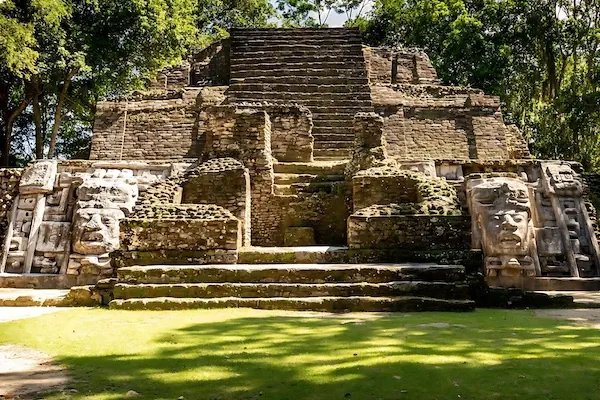
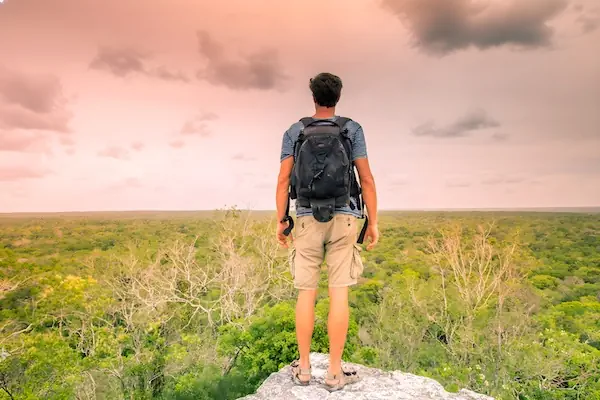
add-on
Ready for another Mayan adventure? Let’s visit the Calakmul Mayan ruins, one of the most powerful ancient cities in the Mayan world. This ruin is in Campeche, Mexico, next to the Guatemalan border. It’s deep in the jungle and definitely off the beaten path. Built between 600 BCE and 250 CE, Calakmul had around 50,000 residents at its height, but it held political power over settlements all over the Maya lowlands, up to 90 miles away.
Calakmul was considered the head of the Snake Kingdom, and you can find snake head emblems on buildings and stelae in the area. It became so powerful that it actually captured Tikal in 562 CE. This political rivalry has become a much-studied piece of Maya history and you’ll learn more about it as you walk through the ruins of this impressive city with your guide.
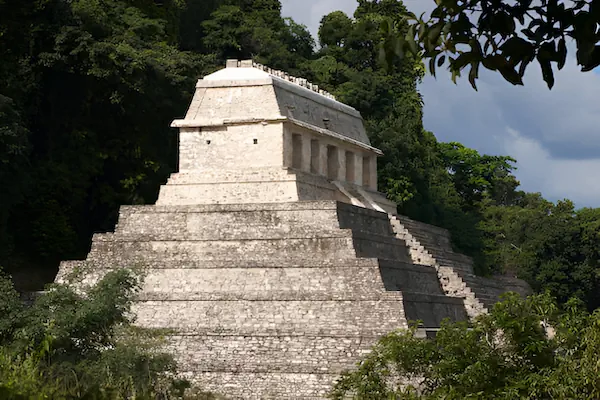
add-on
If ancient architecture interests you, Palenque is certainly a must-see Mayan ruin. Covering over 600 acres with 200 buildings, Palenque is a green city that is still beautiful, even in ruins. The architecture is the biggest reason people visit the site. You’ll admire the elegance of the buildings here, with their intricate carved decor, sloped roofs, and stunningly decorated temples.
Many of the temples and even the palace complex are still in remarkably good condition, so you can really see what the builders created. Much of the impressive architecture is due to K’inich Janaab Pakal or Pakal the Great. He became ruler at the tender age of 12 and ruled from 615-683 CE. He built the Palace (which featured one of the first known flushing toilets), the Temple of the Inscriptions, and several other of the more elegant buildings. His tomb later became valuable evidence of Maya burial customs and cosmology. There’s no doubt that Palenque has been an informative place to study Mayan life.
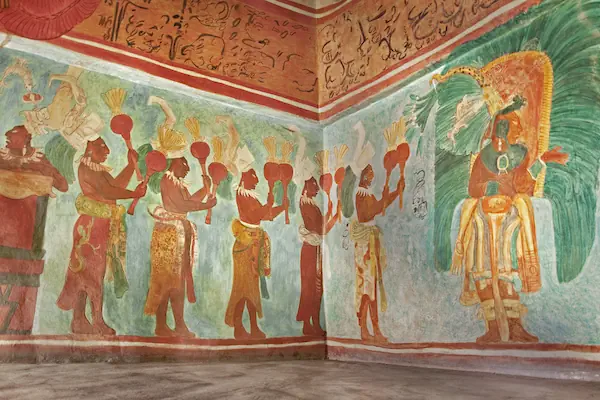
add-on
Ready for a true Mayan adventure? This extension will take you to Chiapas first to visit Yaxchilan, beside the Usumacinta River. During the Classic period, Yaxchilan was a very powerful city-state and held a defensible position atop steep hills with terraces. This made it a valuable site for trade and military at the time. Throughout the city, you’ll find carved lintels and inscriptions, which are very well preserved and give us insight into a number of ritual ceremonies. It was famous for its ritual warfare acts and for its links with Palenque, Tikal, and Piedras Negras.
Next, we’ll head to Bonampak, just a short drive from Yaxchilan. The city itself is fairly small and was dependent on Yaxchilan. The local Maya still used the temples here for rituals in 1949, when the first outsiders found it. The city is best known for the Temple of Murals, since the interior is heavily decorated with beautiful murals that depict battle scenes, ceremonies, political scenes and plenty of blood sacrifices. It’s a fascinating look at the Mayan world and daily lifestyle.
Your adventure finishes up with a trip to the Lacandon Jungle, one of the largest montane rainforests in Mexico. The biodiversity here is unimaginable, with thousands of different tree species and nearly all of the country’s animal, bird, and butterfly species. It’s also home to several Mayan cities, including Palenque, Yaxchilan, and Bonampak.
While you’re here, you can hike through the forest, but you’ll also visit the Lacandon Community where the Lacandon Maya or Hach Winik still live. This Maya group is quite isolated and still follows traditional ways of life. Until recently, the group had virtually no outside influence. As the Spanish appeared, the Lacandon retreated further and further into the rainforest, preserving their language and culture. You’ll have a chance to learn more about their culture during your visit.

